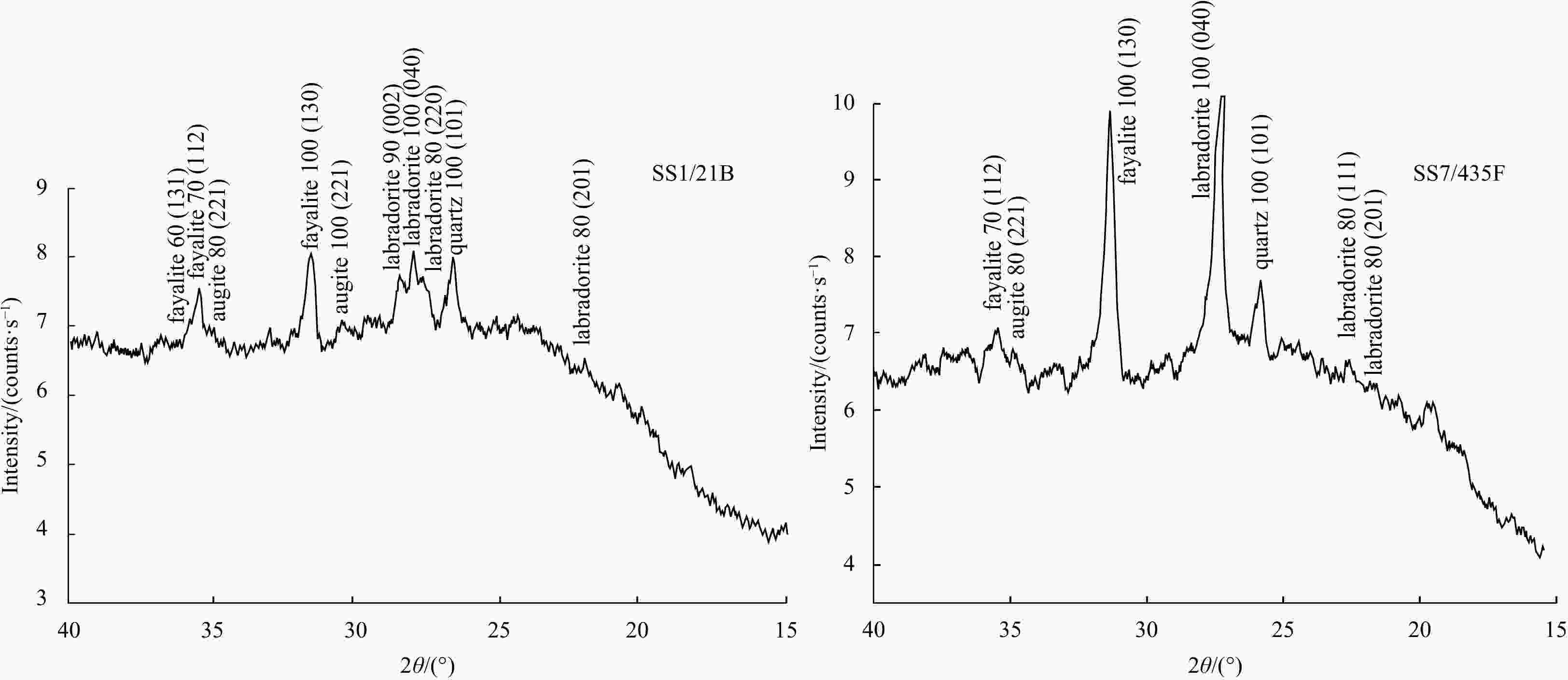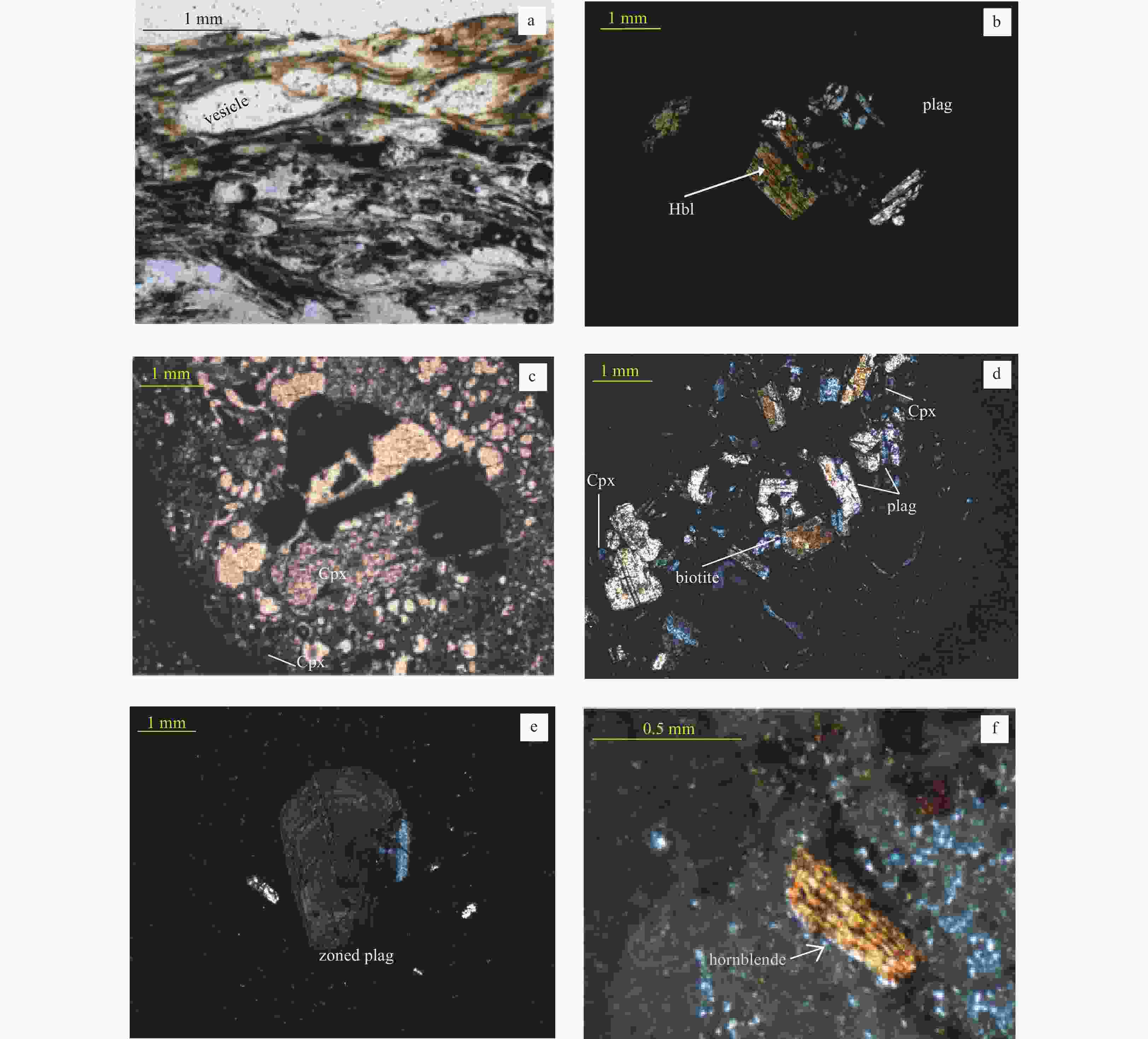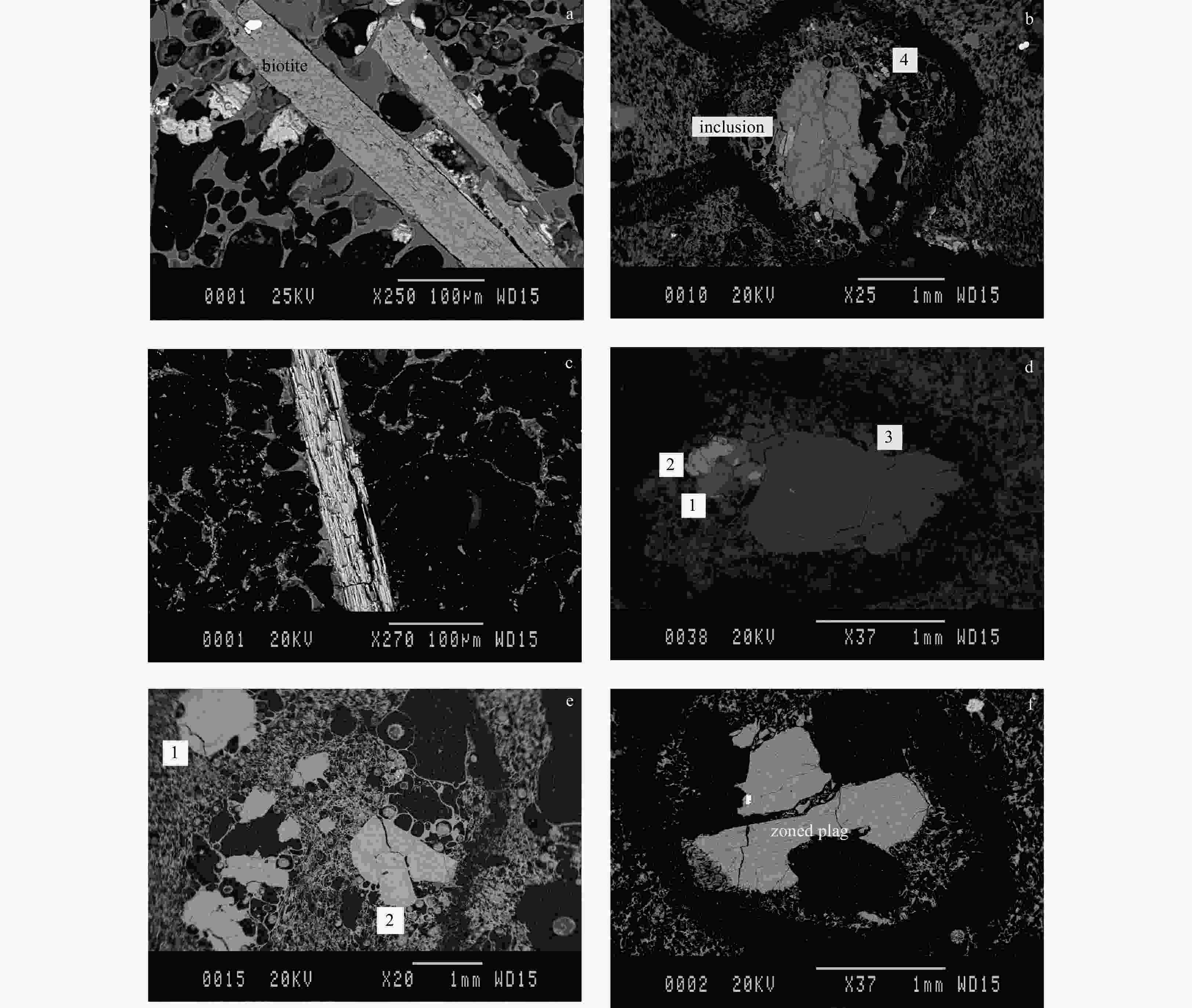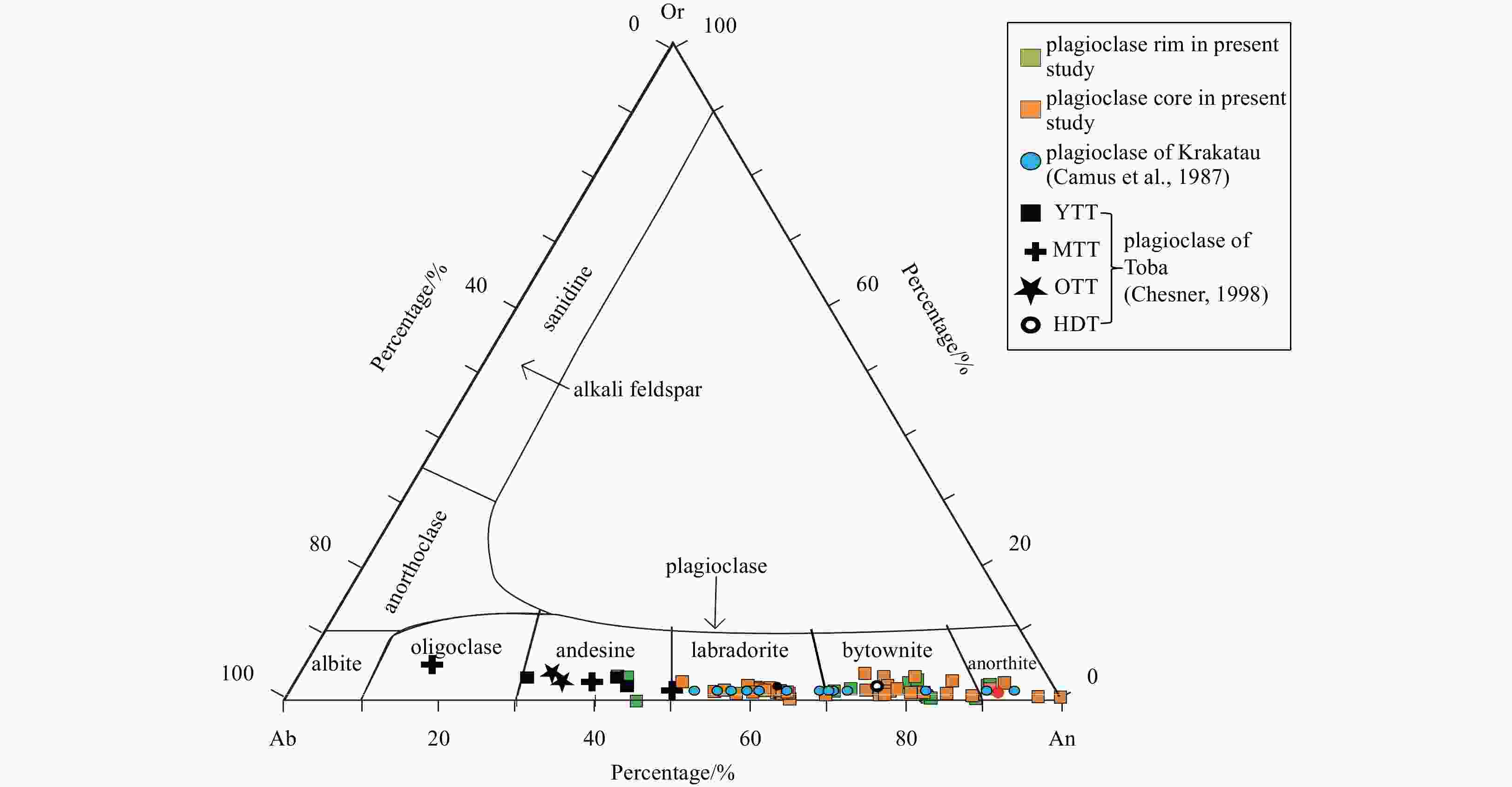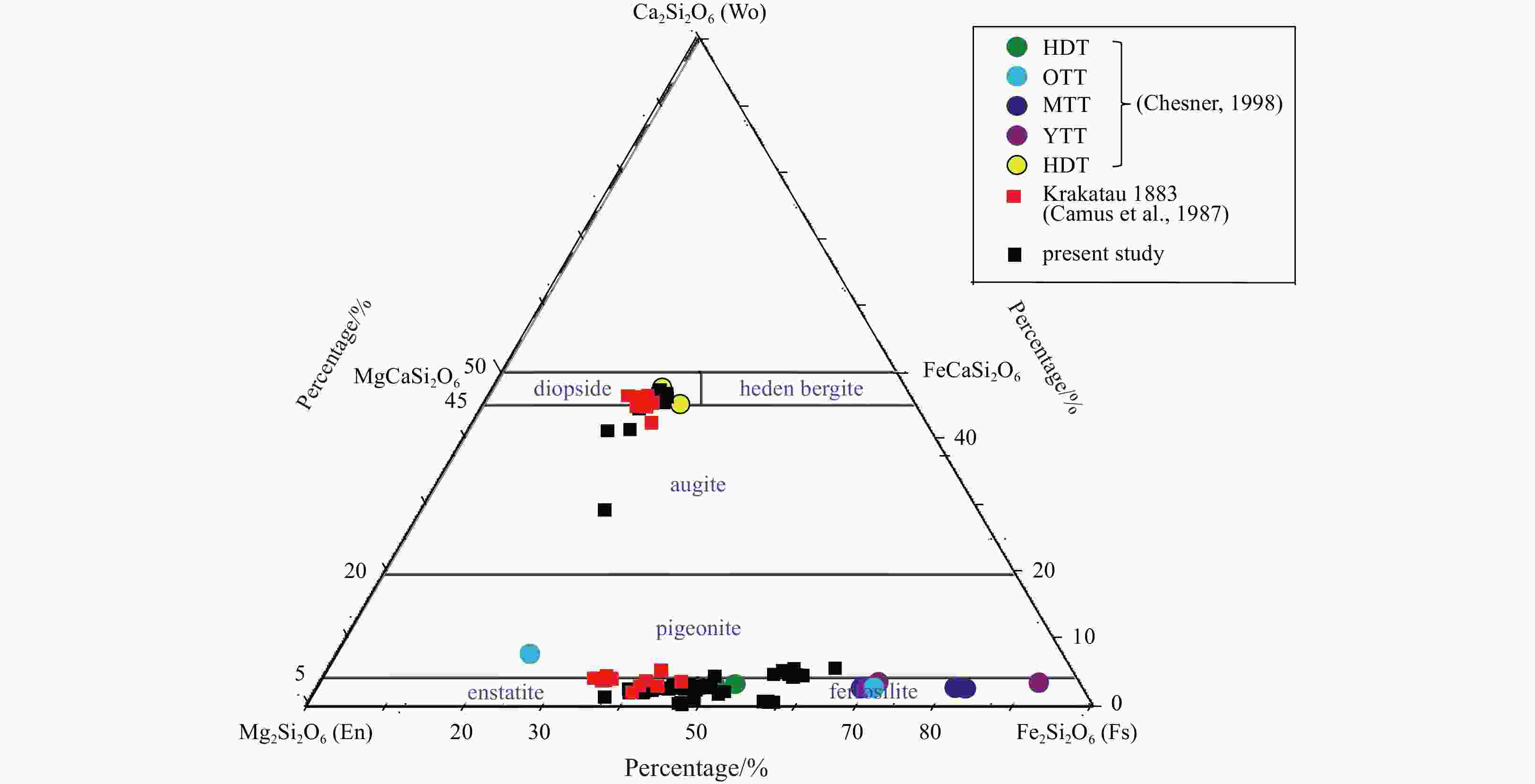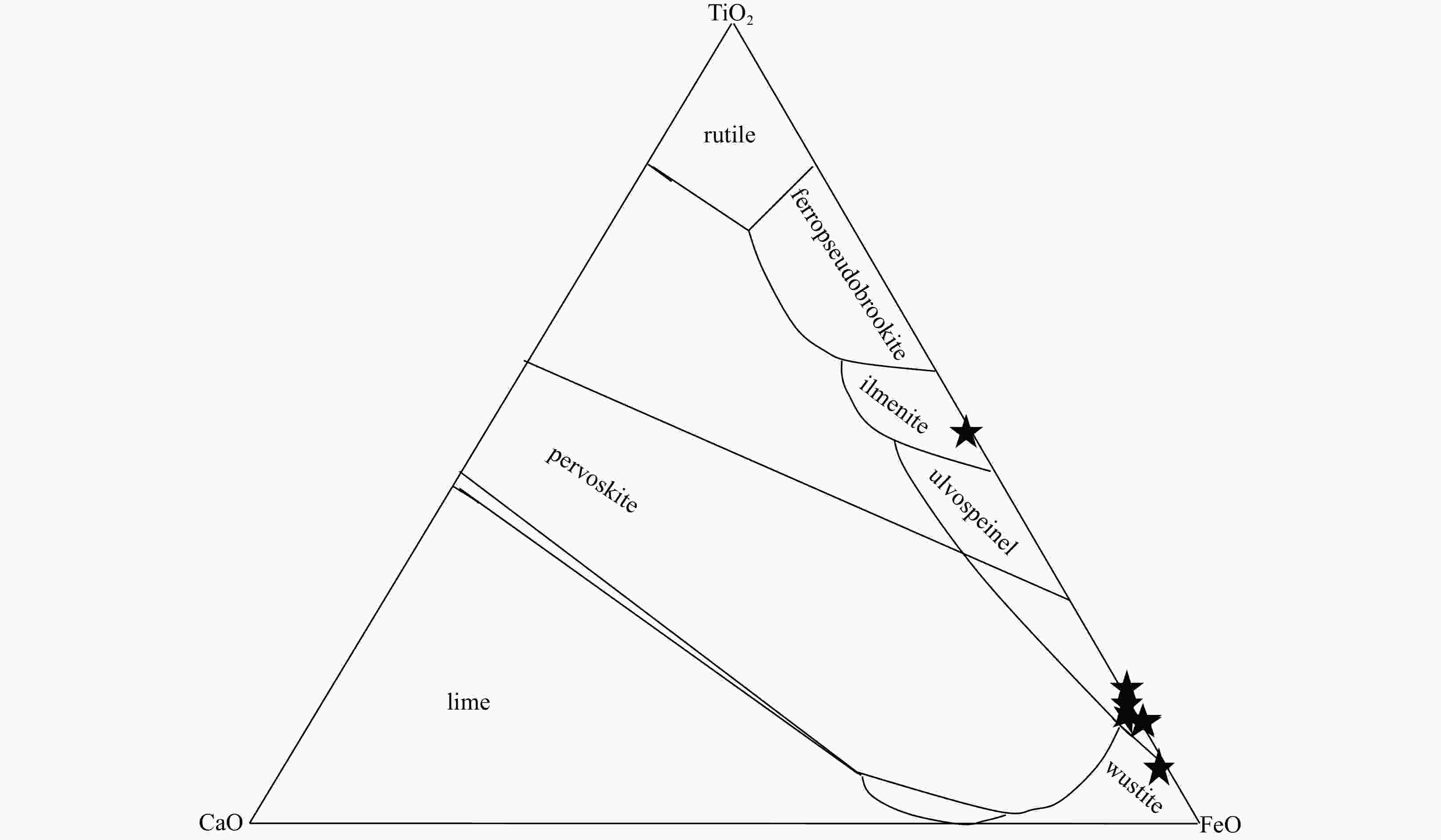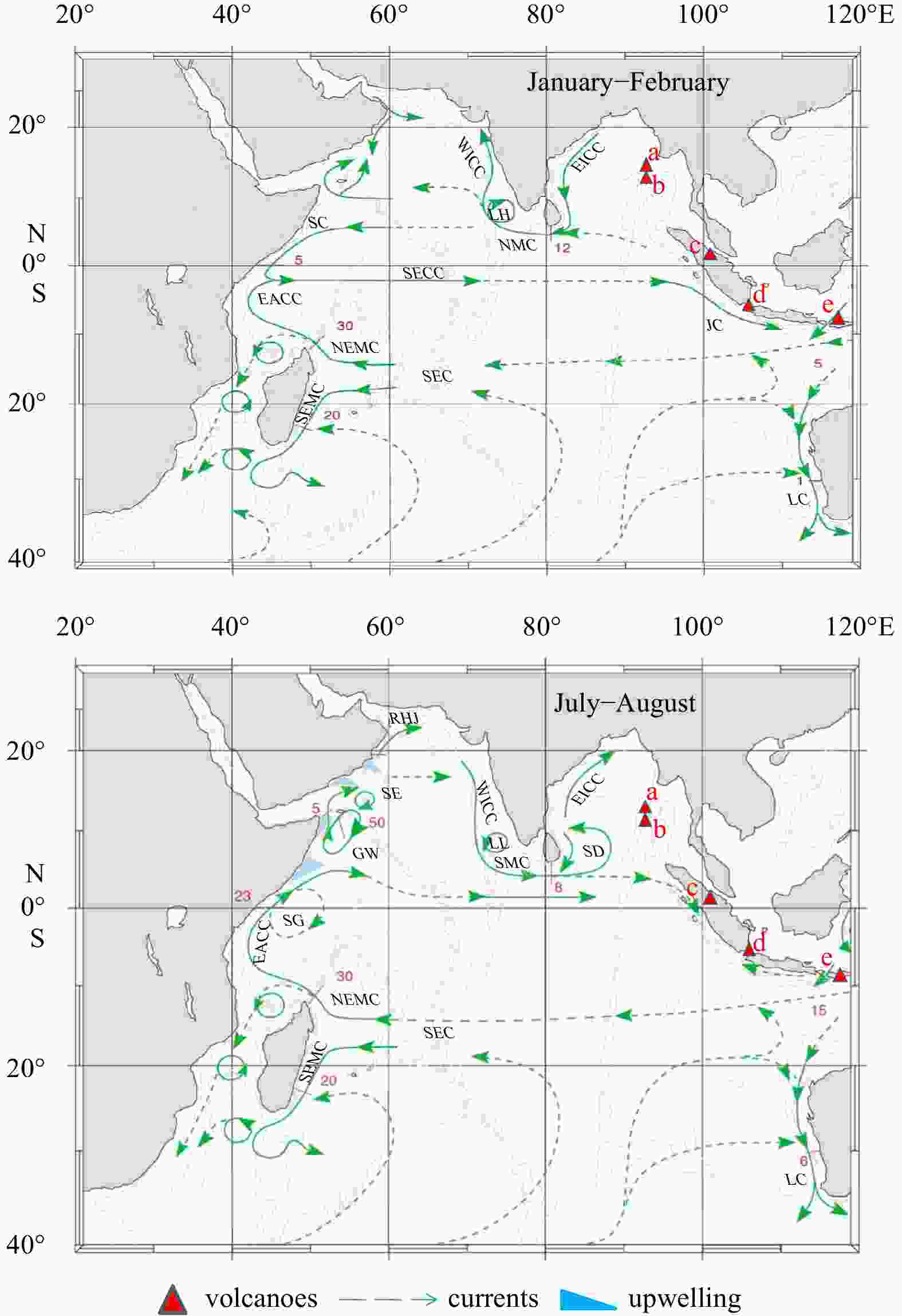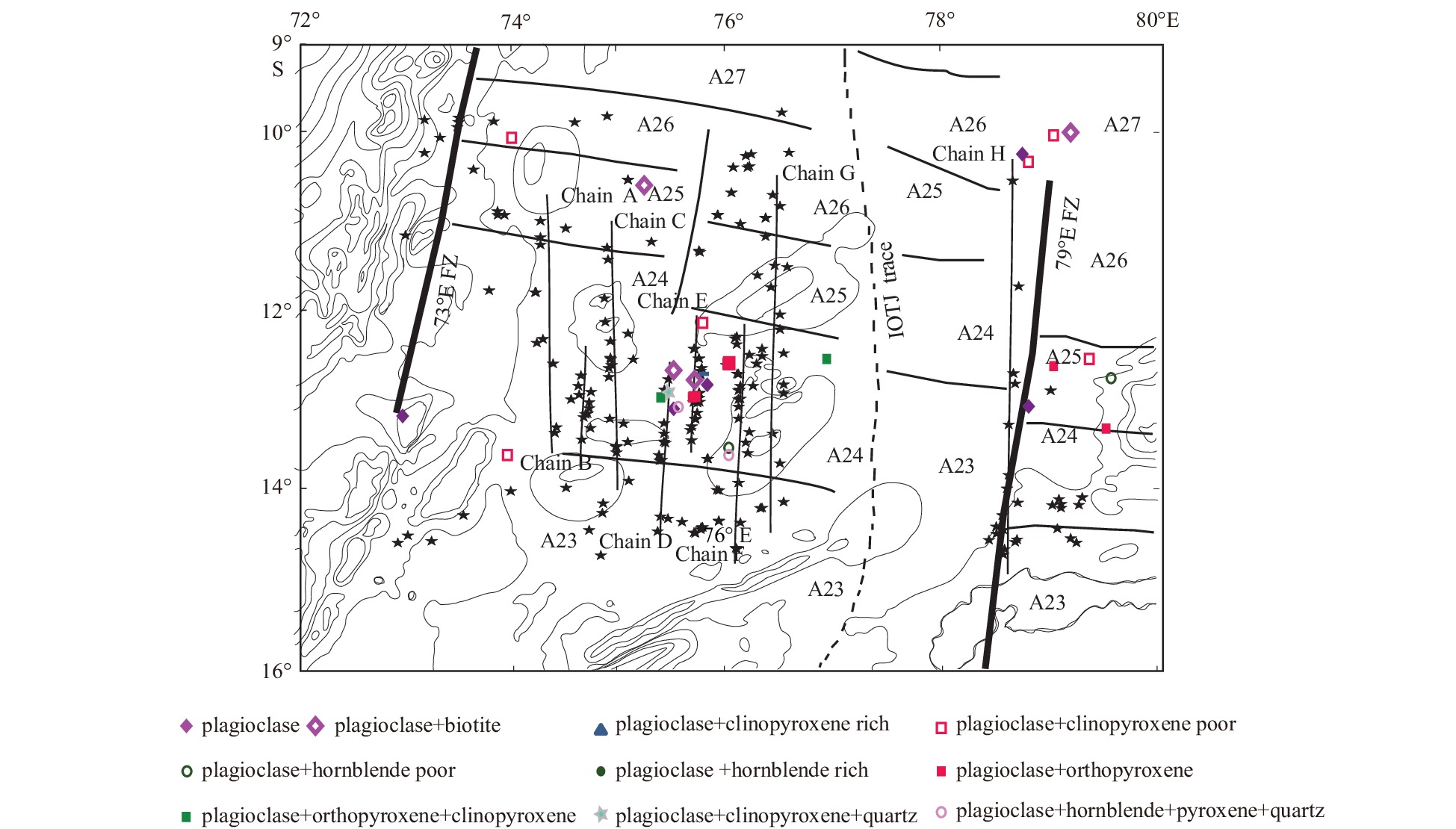Petrographical and mineral chemistry evidence to delineate the source/sources of the Central Indian Ocean Basin pumices
-
Abstract: We present data pertaining to mineral assemblages and composition of the Central Indian Ocean Basin (CIOB) pumices. Eight groups of pumices were identified considering the presence of phenocrysts of plagioclase, clinopyroxene, orthopyroxene, hornblende and biotite together with the occurrence of quartz and glass. Pigeonite, fayalite and ulvospinelare reported for the first time from these pumices. In the eight groups, the modal percentage of the constituents are phenocrysts 3% to 19% (avg 9.6%), silicic glass 33% to 54% (avg 43%) and the rest is vesicles. Based on the above factors we have identified the possible sources of the CIOB pumices. The mineral compositions of plagioclase, pyroxenes, and biotite of the CIOB pumices were compared with those of Krakatau and Toba. Most of the plagioclase and pyroxene compositions resemble the Haranggoal Dacite Tuff of Toba and Krakatau. Considering the mineral assemblages and compositions, there are pumices which do not correlate to any of the above eruptions and are probably from yet unidentified source/sources. These sources could either be from nearby terrestrial volcanoes or intraplate seamounts present in the CIOB. In a global context, it is viable that petrological characteristics could be used as initial criteria to determine the source of pumices that occur at abyssal depths in the world ocean.
-
Key words:
- CIOB /
- pumice /
- petrography /
- mineral chemistry /
- Indonesian Arc /
- intraplate volcanism
-
Figure 1. Station location map for the studied Central Indian Ocean Basin pumices. A to H seamount chains along propagative fracture zones are shown. IOTJ: Indian Ocean Triple Junction; FZ: fracture zone. Contour intervals are in 100 m. Base map after Das et al. (2007). Mineral groups are as shown in Table 2. A23, A24, etc. are magnetic anomalies.
Figure 5. The plot displays the rim and core compositions for the plagioclases of the Central Indian Ocean Basin, plagioclases of Krakatau pumices (Camus et al., 1987) and plagioclase composition of Toba pumices (Chesner, 1998). YTT: Younger Toba Tuff; MTT: Middle Toba Tuff; OTT: Older Toba Tuff; HDT: Haranggoal Dacite Tuff. Or: orthoclase.
Figure 6. Pyroxene classification diagram. Pyroxenes of the Central Indian Ocean Basin pumices plotted along with pyroxenes from Krakatau pumices (Camus et al., 1987) and pyroxenes from Toba eruptives (YTT, MTT, OTT) (Chesner, 1998). HDT: Haranggoal Dacite Tuff; OTT: Older Toba Tuff ; MTT: Middle Toba Tuff; YTT: Younger Toba Tuff; HDT: Haranggoal Dacite Tuff.
Figure 7. Oxides-ilmenite-ulvospinel plot after Kimura and Muan (1971). The Fe-Ti oxides from the Central Indian Ocean Basin pumices plot within the ilmenite-ulvospinel field.
Figure 8. A schematic representation of currents observed during the months January–February and July–August in the Indian Ocean. These currents may have helped to transport pumice clasts across the Indian Ocean from the nearby terrestrial volcanoes while the water-laden clasts may have sunk in the Central Indian Ocean Basin. The currents identified are: South Equatorial Current (SEC); South Equatorial Counter Current (SECC); Northeast and Southeast Madagascar Current (NEMC and SEMC); East Africa Coastal Current (EACC); Somali Current (SC), West India Coastal Current (WICC); Lakshadweep High (LH); East India Coastal Current (EICC); Northeast Monsoon Current (NMC); South Java Current (JC); and Leeuwin Current (LC). The Indo-Pacific Throughflow, which enters from the east, influences both the SEC and the LC. The base figure is modified from Schott and McCreary (2001). The volcanoes marked are Narcondum (a), Barren (b), Toba (c), Krakatau (d), and Tambora (e).
Table 1. Station location, water depth and morphology of pumices used in this study
No. Station a/cm b/cm c/cm Shape Latitude Longitude Water depth/m 1 F1/42 A − − − − 10.02°S 74.01°E NA 2 AAS 26−5 7 5.5 3 oblate 12.52°S 75.69°E NA 3 AAS 26−16 5 3 2.5 prolate 12.70°S 75.76°E 5 410 4 AAS 22−13 4 3.5 3 equant 12.08°S 75.80°E 5 220 5 F1/48D − − − − 13.08°S 73.01°E 5 114 6 F1/47D − − − − 13.50°S 73.99°E 5 088 7 SK 23/277D − − − − 11.00°S 78.74°E 5 110 8 SS13/696 3.2 2.8 2.1 equant 12.75°S 79.50°E 5 070 9 SS13/696 3.2 1.5 1 equant 12.75°S 79.50°E 5 070 10 AAS 27/12a − − − − 12.75°S 75.82°E 5 260 11 AAS 27/12b − − − − 12.75°S 75.82°E 5 260 12 SS6/372 − − − − 11.00°S 78.00°E NA 13 SS13/704C 7.5 5.3 2 oblate 12.45°S 79.30°E 5 250 14 AAS 26−9 15 11 3 oblate 12.50°S 75.67°E 5 260 15 AAS 3/B15/65a 6.8 6 4.8 equant 12.60°S 75.5°E 5 320 16 SK 23/255 B 7 5 4 equant 9.99°S 78.97°E 5 260 17 AAS 26−33 13 9 9 equant 12.93°S 75.44°E 5 220 18 AAS 26−7 10 7 5 equant 12.54°S 75.67°E 5 180 19 AAS 26−46 B 9 6 4 equant 10.53°S 78.74°E 5297 20 AAS 3/B15/57 13 7.7 5.5 prolate 10.54°S 75.21°E 5 281 21 SS 23/255 CD 7 5 4 equant 9.98°S 78.97°E 5 235 22 AAS 26−44 4 2 1 bladed 12.96°S 75.49°E 5 280 23 AAS 26−19 9.5 6 5 equant 12.74°S 75.75°E 5 350 24 SS7/435C 4.4 3.5 2.5 equant 10.23°S 78.77°E 5 400 25 AAS 26−14 9 5 4 prolate 12.52°S 75.52°E 5 230 26 SS13/683 7 5 5 equant 13.51°S 76.00°E 5 250 27 AAS 27/12c − − − − 12.75°S 75.82°E 5 260 28 AAS 26−43 18 10.5 4 bladed 12.98°S 75.51°E 5 265 29 AAS 26−27 10.5 5 3 bladed 12.71°S 75.72°E 5 360 30 AAS 26−43 11 10 6 oblate 12.97°S 75.51°E 5 265 31 AAS 26−31 10 5 1 bladed 12.89°S 75.39°E 5 210 32 AAS 26−30 10 6 3 bladed 12.88°S 75.39°E NA 33 AAS3/B15/69 7.1 5.2 3 oblate 12.73°S 75.70°E 5 305 34 SS10/650C 5.6 3.1 1 bladed 12.46°S 76.89°E 5 350 35 AAS 22−16 11.5 11 6.2 oblate 12.49°S 76.02°E 5 280 36 SS13/691C 8.5 7 5 equant 13.51°S 76.00°E 5 250 37 SS13/691C 6.5 4 2.8 prolate 13.51°S 76.00°E 5 250 38 AAS 26−36 5 3 2 prolate 12.97°S 75.47°E 5 270 39 AAS 26−19 9.5 6 5 prolate 12.74°S 75.75°E 5 350 40 SS13/683 A 4 2 1 bladed 13.51°S 76.00°E 5 250 41 SS1/21B 4.4 2.7 2.4 equant 11.99°S 81.03°E 5 250 42 SS7/435F 4.4 3 2.7 equant 10.22°S 78.76°E 5 400 43 SS7/469 D 5.9 2.6 2 prolate 13.24°S 79.50°E 5 000 44 SS2/104C 3 2.4 1.6 equant 12.00°S 74.99°E 5180 45 SS7/464E 4.8 2.9 1.4 bladed 12.97°S 78.75°E 5 100 46 AAS3/B15/67 4.2 3.1 1 prolate 12.73°S 75.69°E 5 299 47 AAS3/B15/65b 5.6 4.2 3.2 equant 12.62°S 75.57°E 5 320 48 AAS3/B15/59 8 5.3 4.5 prolate 13.49°S 76.99°E 5 356 49 F1/41B − − − − 13.49°S 76.99°E 5 356 50 SS12/676V 6.2 4.4 5 equant 12.53°S 79.01°E 5 270 51 SS13/704C 7.5 5.3 2 oblate 12.45°S 79.31°E 5 250 52 SS13/691A 5.5 5.1 4.1 equant 12.17°S 79.20°E 5 440 53 AAS3/B15/60 9.7 7.8 3.1 oblate 10.59°S 75.12°E 5 250 54 AAS3/B15/62 5.1 3.2 2.9 prolate 12.867°S 75.69°E 5 329 Note: a: length; b: width; c: height; NA: not available; − represents no data. Table 2. The sub-groups of pumice based on mineralogy within the major eight groups
Group 1 Group 2 Group 3 Group 4 Group 5 Group 6 Group 7 Group 8 Plag Plag +Cpx Plag+Opx Plag+biotite Plag+Hbl Plag+Opx+
CpxPlag+Hbl+
Pyx+QtzPlag+Cpx+
Qtz− Cpx rich Cpx poor − − Hbl rich+Plag poor Plag rich+
Hbl poor− − − AAS 26−44 AAS 26−19 SK 23/255B SS10/650C AAS 26−36 AAS 26−5 oblate SS6/372 AAS 26−30 SS13/691C SS1/21B AAS 26−19 AAS 27/12 F1/47D AAS 22−16 AAS 3/B15/57 AAS3/B15/67 prolate SS13/683 SS10/650C − − AAS 27/12 − SS13/704C AAS 26−31 SK 23/255 CD − SS13/696 − − − F1/48D − SS7/435C − AAS 26−43 − − − − − SS7/464E − F1/42A AAS 26−43 AAS3/B15/59 − − − − − SS7/435C − − SS7/469D AAS3 B15/65 − − − − − − − − SS13/704C AAS 27/12 − − − − − − − − SS12/676V − − − − − − Note: Plag: plagioclase; Cpx: clinopyroxene; Opx: orthopyroxene; Hbl: hornblende; Qtz: quartz; − represents no data. Table 3. Microprobe analysis of core and rim of plagioclase grains in the Central Indian Ocean Basin pumices
Analysis of core of plagioclase grains Phenocrysts Sample SiO2 TiO2 Al2O3 FeO MnO BaO CaO Na2O K2O Total An Ab Or n=6 A42 56.17 bd 29.18 0.42 0.09 0.20 10.03 1.80 0.28 98.04 83.73 13.74 2.54 n=9 A39 57.75 0.11 27.80 0.42 0.11 0.07 8.70 2.15 0.13 97.39 78.98 19.82 1.20 n=3 S2 58.25 bd 26.60 0.20 0.38 bd 9.81 5.51 0.15 100.66 63.42 35.61 0.97 n=4 S1 54.36 0.07 26.03 0.47 0.04 0.04 9.43 5.23 0.18 97.13 63.75 35.33 0.92 n=2 A13 58.31 0.12 24.89 0.47 bd 0.02 7.82 6.18 0.34 98.67 54.46 43.21 2.34 n=1 S15 54.98 bd 25.82 0.47 0.11 0.03 9.69 5.21 0.16 97.27 64.34 34.59 1.06 n=4 A33 53.43 0.08 30.12 0.22 0.02 0.06 11.54 3.84 0.10 100.24 74.49 20.07 1.00 n=5 S7 61.24 bd 25.85 0.22 0.04 0.07 6.11 4.29 0.12 97.97 58.06 40.78 1.16 n=1 A15 57.05 bd 32.56 0.45 bd 0.17 9.85 1.25 0.05 101.80 88.34 11.21 0.45 Analysis of rim of plagioclase grains Phenocrysts Sample SiO2 TiO2 Al2O3 FeO MnO BaO CaO Na2O K2O Total An Ab Or n=5 A42 56.43 bd 29.11 0.43 0.07 0.24 10.13 1.44 0.26 97.92 87.34 10.37 2.28 n=8 A39 57.88 0.07 27.70 0.47 0.18 0.08 8.47 2.43 0.12 97.30 76.79 22.12 1.09 n=4 S2 61.71 0.13 22.93 0.19 0.29 bd 5.99 6.98 0.45 98.33 44.98 52.51 2.52 n=3 S1 55.32 0.06 25.56 0.41 0.11 0.13 9.19 5.40 0.16 97.03 62.33 36.61 1.06 n=3 A15 57.20 bd 32.49 0.44 0.08 0.12 9.72 1.31 0.08 101.69 87.46 11.85 0.69 n=1 S9 57.83 0.02 25.56 0.21 bd 0.11 7.74 6.32 0.24 98.80 54.13 44.20 1.68 n=2 A13 57.73 0.06 25.30 0.46 bd 0.05 8.36 5.94 0.21 98.47 57.60 40.95 1.46 n=1 S15 57.62 bd 25.51 0.41 0.03 bd 8.58 5.71 0.06 98.39 59.79 39.79 0.42 n=2 A33 57.85 0.08 27.29 0.17 0.05 bd 8.31 5.97 0.13 100.63 57.71 41.43 0.87 n=1 S9 57.83 0.02 25.56 0.21 bd 0.11 7.74 6.32 0.24 98.80 54.13 44.20 1.68 n=2 A30 57.28 bd 28.03 0.47 bd 0.18 8.87 2.01 0.27 97.49 79.55 18.03 2.42 n=2 S7 61.85 bd 25.58 0.19 0.03 0.03 5.75 4.65 0.17 98.29 54.31 44.10 1.61 n=1 A31 58.36 0.03 28.00 0.47 bd 0.03 8.55 2.83 0.26 98.52 73.45 24.31 2.23 Note: bd: below detection. Table 4. Microprobe analysis of pyroxene grains in the Central Indian Ocean Basin pumices
Phenocrysts Sample SiO2 TiO2 Al2O3 FeO MnO MgO CaO Na2O K2O Cr2O3 Total Wo En Fs n=25 A42 54.01 0.23 0.83 18.64 1.27 24.27 1.82 0.04 0.03 0.06 101.10 4.06 54.25 41.69 n=17 A30 53.22 0.28 0.62 19.28 1.22 19.71 4.64 0.10 0.02 bd 99.03 10.71 45.14 44.15 n=10 A31 53.62 0.43 0.63 21.19 1.21 22.97 1.04 0.04 0.50 bd 100.98 2.30 50.82 46.88 n=4 S7 53.29 0.62 2.53 25.70 1.29 14.24 2.12 0.23 0.03 bd 99.69 5.04 33.85 61.11 n=16 A39 53.56 0.38 1.00 15.93 1.40 21.03 6.91 0.10 0.10 0.26 100.34 16.06 47.78 36.16 n=6 S11 52.52 0.22 0.48 21.71 1.36 21.76 1.20 0.06 0.01 bd 99.26 2.68 48.72 48.60 n=1 S2 55.43 0.08 bd 16.72 2.56 27.06 0.60 bd bd bd 102.44 1.35 60.97 37.68 n=1 A15 54.89 0.54 2.01 7.82 0.53 17.59 17.81 0.15 bd 0.27 101.60 41.21 40.69 18.10 n=1 S1 54.09 0.25 0.74 21.15 1.52 23.37 1.30 0.04 bd bd 102.45 2.84 51.01 46.15 n=5 A25 55.03 0.56 2.59 23.87 1.26 14.27 1.92 0.30 bd bd 99.79 4.79 35.63 59.58 n=1 A2 49.99 1.99 13.56 7.93 1.19 15.73 9.81 0.95 0.32 bd 101.47 29.31 47.00 23.69 n=2 A13 52.48 0.05 1.09 20.95 1.27 21.99 0.35 bd 1.50 bd 99.66 0.81 50.80 bd n=2 S15 52.90 0.04 0.44 26.61 1.49 17.97 0.29 bd 1.62 bd 101.33 0.64 40.05 59.32 Note: Wo: wollastonite; En: enstatite; Fs: ferrosilite; bd: below detection. Table 5. Electron Dispersive Spectroscopy analysis of hornblende grains in Sample A33 (AAS26−43)
Phenocrysts Sample SiO2 TiO2 Al2O3 FeO MnO MgO CaO Na2O K2O Total n=5 A33 50.52 1.4 6.636 12.602 0.265 14.65 10.285 1.72 0.266 96.27 Table 6. Microprobe analysis of biotites grains in Sample A25 (AAS 3/B15/57)
Phenocrysts Sample SiO2 TiO2 Al2O3 FeO MnO MgO CaO Na2O K2O Total n=5 A33 50.52 1.4 6.636 12.602 0.265 14.65 10.285 1.72 0.266 96.27 Table 7. Microprobe analysis of iron-titanium oxides in the Central Indian Ocean Basin pumices
Phenocrysts Sample SiO2 TiO2 Al2O3 FeO MnO MgO CaO NiO Cr2O3 Total n=4 A42 0.02 12.20 2.90 81.54 0.85 2.33 0.07 0.02 0.11 99.98 n=3 A31 0.20 13.59 2.48 80.98 0.55 1.99 0.03 0.01 0.26 99.99 n=2 A39 0.12 17.29 2.39 77.01 0.75 2.02 0.04 0.01 0.21 99.72 n=2 S11 0.15 16.80 2.37 77.58 0.75 1.99 0.04 0.01 0.21 99.59 n=3 A32 0.15 14.83 2.38 79.44 0.95 1.99 0.04 0.03 0.18 99.30 Table 8. Electron Dispersive Spectroscopy analysis of glassy matrix of the Central Indian Ocean Basin pumices
Sample SiO2 TiO2 Al2O3 FeO MnO CaO Na2O K2O MgO Total SS7-432D 52.07 1.04 17.57 12.63 0.45 8.90 3.54 0.69 3.12 100.01 SS7-437F 68.94 bd 11.16 8.24 0.52 2.53 4.13 1.40 3.07 99.99 SS7-474C 78.95 bd 12.05 0.84 bd 0.77 3.14 4.25 bd 100.00 SS7-474C 78.92 bd 12.00 0.81 bd 0.65 3.42 4.19 bd 99.99 SS2-66BG 63.26 1.30 13.35 8.82 bd 4.36 4.94 2.23 1.74 100.00 SS7-460C 69.26 0.77 11.60 4.58 bd 2.38 7.76 2.58 1.07 100.00 SS1-57A 68.09 0.61 12.25 3.90 bd 2.41 9.00 2.55 1.19 100.00 SS2-106C 59.55 1.40 15.14 9.12 0.47 5.16 4.27 2.77 2.12 100.00 SS2-106C 59.84 1.13 15.49 9.59 0.65 4.15 3.91 2.89 2.35 100.00 SS4-216 E 77.67 bd 12.17 1.65 bd 0.69 3.61 3.81 0.40 100.00 SS4-216 E 77.67 bd 12.17 1.65 bd 0.69 3.61 3.81 0.40 100.00 SS3 131 A,B 75.32 bd 12.00 3.02 bd 2.03 3.93 3.70 bd 100.00 AAS 26−19 79.80 bd 11.03 1.89 bd 0.53 2.91 3.84 bd 100.00 Note: bd: below detection. Table 9. Comparison of the mineral assemblages of the Central Indian Ocean Basin (CIOB) pumices with those in the vicinity of the basin
Samples Mineral assemblage Reference CIOB pumices plagioclases 1.1% to 9.6% (4.7%) present work clinopyroxene 0.2% to 1.8% (0.8%) orthopyroxene 0.2% to 1.2% (0.55%) biotite 0.2% to 0.4% (0.35%) hornblende 0.4% to 2% (1.2%) quartz (0.4%) (±fayalite+oxides) vesicles 33% to 45.4% (38.2%) glass 32.8% to 53.86% (42.6%) Krakatau 1883 pumice white band grey band Camus et al. (1987) plagioclase (12%) (7.5%) clinopyroxene (rare) (2%) orthopyroxene (rare) (0.5%) oxide (rare) (1%) hornblende, biotite, quartz (not present) Krakatau 1883 pumice plagioclase (5.7%) Oba et al. (1983) clinopyroxene (0.4%) orthopyroxene (0.6%) oxide (1.1%) vesicles (92%) Anak 1927–1979 pumice plagioclase (29%) Oba et al. (1983) olivine (2.5%) (sometimes jacketed by Opx) Anak 1981 pumice clino- and ortho- pyroxene (3%) Oba et al. (1983) magnetite oxide (1%) plagioclase (23%) clinopyroxene (3%) orthopyroxene (3.5%) magnetite and ilmenite oxide (2%) Andaman, Barren and Narcondam andesite and dacite rocks calcic and sodic plagioclase, forsteritic olivine, clinopyroxene, orthopyroxene, hornblende, minor quartz and apatite, andesites and dacites (not pumice), hence modal proportions is not given Ray et al. (2011) Narcondam pumice plagioclase, amphibole, pyroxene Pal et al. (2007) HDT Toba pumice plagioclase, ortho- and clinopyroxene, magnetite, ilmenite Chesner et al. (1998) OTT Toba pumice quartz, plagioclase, sanidine, biotite, amphibole, orthopyroxene, magnetite, ilmenite, allanite, zircon MTT Toba pumice quartz, plagioclase, sanidine, biotite, amphibole, orthopyroxene, magnetite, ilmenite, allanite, fayalite, zircon YTT Toba pumice quartz, plagioclase, sanidine, biotite, magnetite, ilmenite, allanite, fayalite, zircon, orthopyroxene Taupo, New Zealand pumice plagioclase, orthopyroxene, quartz, hornblende, magnetite (as inclusions in orthopyroxene, plagioclase, hornblende or as microphenocrysts), ilmenite, acessory zircon and apatite (as inclusions in orthopyroxene, plagioclase and magnetite and as microphenocrysts) Wilson et al. (2006) South Sandwich pumice plagioclase (andesine-labradorite), corroded feldspar Risso et al. (2002) (sanidine-anorthoclase), clinopyroxene (diopside or augite), orthopyroxene (hypersthene), red-brown hornblende, magnetite,vesicle (50%−60%) Tonga pumice calcic plagioclase, augite, pigeonite, titanomagnetite Bryan et al. (2004) Kerguelen pumice lapilli layer in basaltic and silicic ash fresh sanidine, Ab-rich plagioclase, hedenbergitic clinopyroxene, few quartz Bitschene et al. (1992b) -
Allègre C J, Provost A, Jaupart C. 1981. Oscillatory zoning: a pathological case of crystal growth. Nature, 294(5838): 223–228. doi: 10.1038/294223a0 Almeev R R, Ariskin A A. 1996. Mineral-melt equilibria in a hydrous basaltic system: computer modeling. Geochemistry International, 34(7): 563–573 Amonkar A, Iyer S D, Babu E V S S K, et al. 2020. Extending the limit of widespread dispersed Toba volcanic glass shards and identification of new in-situ volcanic events in the Central Indian Ocean Basin. Journal of Earth System Science, 129(1): 175. doi: 10.1007/s12040-020-01429-6 Beard J S, Ragland P C, Rushmer T. 2004. Hydration crystallization reactions between anhydrous minerals and hydrous melt to yield amphibole and biotite in igneous rocks: Description and Implications. The Journal of Geology, 112(5): 617–621. doi: 10.1086/422670 Binard N, Hékinian R, Cheminée J L, et al. 1992. Styles of eruptive activity on intraplate volcanoes in the Society and Austral hot spot regions: bathymetry, petrology, and submersible observations. Journal of Geophysical Research: Solid Earth, 97(B10): 13999–14015. doi: 10.1029/92JB00692 Bitschene P R, Dehn J, Mehl K W, et al. 1992a. Explosive ocean island volcanism and seamount evolution in the Central Indian Ocean (Kerguelen Plateau). In: Duncan R A, Rea D K, Kidd R B, et al., eds. Synthesis of Results from Scientific Drilling in the Indian Ocean. Geophysical Monograph Series. Washington, DC: American Geophysical Union, 70: 105–113, Bitschene P R, Mehl K W, Schmincke H U. 1992b. Composition and origin of marine ash layers and epiclastic rocks from the Kerguelen Plateau, southern Indian Ocean (Legs 119 and 120). In: Wise S W Jr, Schlich R, et al., eds. Proceedings of the Ocean Drilling Program, Scientific Results. College Station, TX: Ocean Drilling Program, 120: 135–149 Bitschene P R, Schmincke H U. 1990. Fallout tephra layers: composition and significance. In: Heling D, Rothe P, Förstner U, et al., eds. Sediments and Environmental Geochemistry. Berlin, Heidelberg: Springer-Verlag, 48–82 Bryan S E, Cook A, Evans J P, et al. 2004. Pumice rafting and faunal dispersion during 2001–2002 in the Southwest Pacific: record of a dacitic submarine explosive eruption from Tonga. Earth and Planetary Science Letters, 227(1–2): 135–154 Camus G, Gourgaud A, Vincent P M. 1987. Petrologic evolution of Krakatau (Indonesia): Implications for a future activity. Journal of Volcanology and Geothermal Research, 33(4): 299–316. doi: 10.1016/0377-0273(87)90020-5 Cashman K V, Fiske R S. 1991. Fallout of pyroclastic debris from submarine volcanic eruptions. Science, 253(5017): 275–280. doi: 10.1126/science.253.5017.275 Chen Zuxing, Zeng Zhigang, Wang Xiaoyuan, et al. 2020. Element and Sr isotope zoning in plagioclase in the dacites from the southwestern Okinawa Trough: Insights into magma mixing processes and time scales. Lithos, 376–377: 105776, Chesner C A. 1998. Petrogenesis of the Toba Tuffs, Sumatra, Indonesia. Journal of Petrology, 39(3): 397–438. doi: 10.1093/petroj/39.3.397 Chesner C A, Rose W I. 1991. Stratigraphy of the Toba Tuffs and the evolution of the Toba Caldera complex, Sumatra, Indonesia. Bulletin of Volcanology, 53(5): 343–356. doi: 10.1007/BF00280226 Clynne M A. 1999. A complex magma mixing origin for rocks erupted in 1915, Lassen Peak, California. Journal of Petrology, 40(1): 105–132. doi: 10.1093/petroj/40.1.105 Cox K G, Bell J D. 1972. A crystal fractionation model for the basaltic rocks of the New Georgia Group, British Solomon Islands. Contributions to Mineralogy and Petrology, 37(1): 1–13. doi: 10.1007/BF00377302 Das P, Iyer S D, Kodagali V N. 2007. Morphological characteristics and emplacement mechanism of the seamounts in the Central Indian Ocean Basin. Tectonophysics, 443(1–2): 1–18, Fisk M R. 1984. Depths and temperatures of mid-ocean-ridge magma chambers and the composition of their source magmas. Geological Society, London, Special Publications, 13(1): 17–23, Fiske R S, Cashman K V, Shibata A, et al. 1998. Tephra dispersal from Myojinsho, Japan, during its shallow submarine eruption of 1952–1953. Bulletin of Volcanology, 59(4): 262–275. doi: 10.1007/s004450050190 Fouquet Y, von Stackelberg U, Charlou J L, et al. 1991. Hydrothermal activity in the Lau back-arc basin: sulfides and water chemistry. Geology, 19(4): 303–306. doi: 10.1130/0091-7613(1991)019<0303:HAITLB>2.3.CO;2 Frey F A, Coffin M F, Wallace P J, et al. 2000. Origin and evolution of a submarine large igneous province: the Kerguelen Plateau and Broken Ridge, southern Indian Ocean. Earth and Planetary Science Letters, 176(1): 73–89. doi: 10.1016/S0012-821X(99)00315-5 Frick C, Kent L E. 1984. Drift pumice in the Indian and South Atlantic oceans. South African Journal of Geology, 87(1): 19–33 Ginibre C, Wörner G, Kronz A. 2007. Crystal zoning as an archive for magma evolution. Elements, 3(4): 261–266. doi: 10.2113/gselements.3.4.261 Guo Kun, Zhai Shikui, Wang Xiaoyuan, et al. 2018. The dynamics of the southern Okinawa Trough magmatic system: New insights from the microanalysis of the An contents, trace element concentrations and Sr isotopic compositions of plagioclase hosted in basalts and silicic rocks. Chemical Geology, 497: 146–161. doi: 10.1016/j.chemgeo.2018.09.002 Halbach P, Koschinsky A, Seifert R, et al. 1989. Diffuse hydrothermal fluid activity, biological communities, and mineral formation in the North Fiji Basin (SW Pacific): Preliminary results of the R/V Sonne Cruise SO-134. Interridge News, 8: 38–44 Head J W III, Wilson L. 2003. Deep submarine pyroclastic eruptions: Theory and predicted landforms and deposits. Journal of Volcanology and Geothermal Research, 121(3–4): 155–193, Hédervari P. 1982. A possible submarine volcano near the central part of Ninety-East Ridge, Indian Ocean. Journal of Volcanology and Geothermal Research, 13(3–4): 199–211, Hibbard M J. 1981. The magma mixing origin of mantled feldspars. Contributions to Mineralogy and Petrology, 76(2): 158–170. doi: 10.1007/BF00371956 Iyer S D. 1996. A study of the volcanics of the Central Indian Ocean Basin and their relationship to the ferromanganese deposits [dissertation]. Kolkata: Jadavpur University Iyer S D, Amonkar A A, Das P. 2018. Genesis of Central Indian Ocean basin seamounts: morphological, petrological, and geochemical evidence. International Journal of Earth Sciences, 107(7): 2517–2538. doi: 10.1007/s00531-018-1612-z Iyer S D, Banerjee R. 1998. Importance of plagioclase morphology and composition in magmagenesis of the Carlsberg Ridge basalts. Journal of Indian Geophysical Union, 1(2): 63–72 Iyer S D, Karisiddaiah S M. 1988. Morphology and petrography of pumice from the Central Indian Ocean Basin. Indian Journal of Marine Science, 17: 333–334 Iyer S D, Prasad M S, Gupta S M, et al. 1997. Evidence for recent hydrothermal activity in the Central Indian Basin. Deep-Sea Research Part I: Oceanographic Research Papers, 44(7): 1167–1184. doi: 10.1016/S0967-0637(97)00001-0 Iyer S D, Sudhakar M. 1993. Coexistence of pumice and manganese nodule fields—evidence for submarine silicic volcanism in the Central Indian Basin. Deep-Sea Research Part I: Oceanographic Research Papers, 40(5): 1123–1129. doi: 10.1016/0967-0637(93)90092-H Iyer S D, Sudhakar M. 1995. Evidences for a volcanic province in the Central Indian Basin. Journal of Geological Society of India, 46: 353–358 Kalangutkar N G. 2012. Petrology and petrogenesis of pumice from Central Indian Ocean Basin [dissertation]. Goa: Goa University Kalangutkar N G, Iyer S D. 2012. Submarine silicic volcanism: Processes and products. Geo-Spectrum Interface, 6(1): 30–39 Kalangutkar N G, Iyer S D, Ilangovan D. 2011. Physical properties, morphology and petrological characteristics of pumices from the Central Indian Ocean Basin. Acta Geologica Sinica, 85(4): 826–839. doi: 10.1111/j.1755-6724.2011.00488.x Kalangutkar N G, Iyer S D, Mascarenhas-Pereira M B L, et al. 2015. Hydrothermal signature in ferromanganese oxide coatings on pumice from the Central Indian Ocean Basin. Geo-Marine Letters, 35(3): 221–235. doi: 10.1007/s00367-015-0402-x Kano K. 2003. Subaqueous pumice eruptions and their products: A review. In: White J D L, Smellie J L, Clague D A, eds. Explosive Subaqueous Volcanism. Geophysical Monograph Series. Washington, DC: American Geophysical Union, 140: 213–229 Kato Y. 1987. Woody pumice generated with submarine eruption. Journal of Geological Society of Japan, 93(1): 11–20 Kidd R B, Ramsay A T S, Sykes T J S, et al. 1992. An Indian Ocean framework for paleoceanographic synthesis based on DSDP and ODP results. In: Duncan R A, Rea D K, Kidd R B, et al., eds. Synthesis of Results from Scientific Drilling in the Indian Ocean. Geophysical Monograph Series. Washington, DC: American Geophysical Union, 70: 403–422, Kimura S, Muan A. 1971. Phase relations in the system CaO-iron oxide-TiO2 in air. American Mineralogist: Journal of Earth and Planetary Materials, 56(7–8), 1332–1346 Kodagali V N. 1998. A pair of seamount chains in the Central Indian Basin, identified from multibeam mapping. Marine Geodesy, 21(2): 147–158. doi: 10.1080/01490419809388130 Kokelaar P, Busby C. 1992. Subaqueous explosive eruption and welding of pyroclastic deposits. Science, 257(5067): 196–201. doi: 10.1126/science.257.5067.196 Lonsdale P, Hawkins J. 1985. Silicic volcanism at an off-axis geothermal field in the Mariana Trough back-arc basin. Geological Society of American Bulletin, 96(7): 940–951. doi: 10.1130/0016-7606(1985)96<940:SVAAOG>2.0.CO;2 Martín-Barajas A, Lallier-Verges E. 1993. Ash layers and pumice in the Central Indian Basin: relationship to the formation of manganese nodules. Marine Geology, 115(3–4): 307–329, Mascarenhas-Pereira M B L, Nath B N, Borole D V, et al. 2006. Nature, source and composition of volcanic ash in sediments from a fracture zone trace of Rodriguez Triple Junction in the Central Indian Basin. Marine Geology, 229(1–2): 79–90, Mudholkar A, Fujii T. 1995. Fresh pumice from the Central Indian Basin: A Krakatau 1883 signature. Marine Geology, 125(1–2): 143–151, Mueller W, White J D L. 1992. Felsic fire-fountaining beneath Archean seas: Pyroclastic deposits of the 2730 Ma Hunter Mine Group, Quebec, Canada. Journal of Volcanology and Geothermal Research, 54(1–2): 117–134, Mukherjee A D, Iyer S D. 1999. Synthesis of morphotectonics and volcanics of the Central Indian Ocean Basin. Current Science, 76(3): 296–304 Mukhopadhyay R, Ghosh A K, Iyer S D. 2018. The Indian Ocean Nodule Field: Geology and Resource Potential. 2nd ed. Amsterdam: Elsevier Müller A, Breiter K, Seltmann R, et al. 2005. Quartz and feldspar zoning in the eastern Erzgebirge Volcano–Plutonic Complex (Germany, Czech Republic): evidence of multiple magma mixing. Lithos, 80(1–4): 201–227, Neumann von Padang M. 1967. Catalogue of active volcanoes of the world part xxi Atlantic Ocean. Roma: International Association of Volcanology, 128 Oba N, Tomita K, Yamamoto M, et al. 1983. Geochemical study of volcanic products, in particular to pumice flow, of the Krakatau Group, Indonesia. Reports of the Faculty of Science, Kagoshima University (Earth Sciences and Biology), (16): 21–41 Pal T, Mitra S K, Sengupta S, et al. 2007. Dacite–andesites of Narcondam volcano in the Andaman Sea—an imprint of magma mixing in the inner arc of the Andaman–Java subduction system. Journal of Volcanology and Geothermal Research, 168(1–4): 93–113, Pattan J N, Mudholkar A V, Jai Sankar S, et al. 2008. Drift pumice in the Central Indian Ocean Basin: Geochemical evidence. Deep-Sea Research Part I: Oceanographic Research Papers, 55(3): 369–378. doi: 10.1016/j.dsr.2007.12.005 Pattan J N, Parthiban G, Moraes C, et al. 2016. A note on chemical composition and origin of ferromanganese oxide coated and uncoated pumice samples from Central Indian Ocean Basin. Journal of the Geological Society of India, 87(1): 62–68. doi: 10.1007/s12594-016-0374-0 Pattan J N, Pearce N J G, Parthiban G, et al. 2013. The origin of ferro-manganese oxide coated pumice from the Central Indian Ocean Basin. Quaternary International, 313–314: 230–239, Poulsen H F, Neuefeind J, Neumann H B, et al. 1995. Amorphous silica studied by high energy X-ray diffraction. Journal of Non-Crystalline Solids, 188(1–2): 63–74, Ray J S, Pande K, Awasthi N. 2013. A minimum age for the active Barren Island volcano, Andaman Sea. Current Science, 104(7): 934–939 Ray D, Rajan S, Ravindra R, et al. 2011. Microtextural and mineral chemical analyses of andesite–dacite from Barren and Narcondam islands: Evidences for magma mixing and petrological implications. Journal of Earth System Science, 120(1): 145–155. doi: 10.1007/s12040-011-0006-4 Risso C, Scasso R A, Aparicio A. 2002. Presence of large pumice blocks on Tierra del Fuego and South Shetland Islands shorelines, from 1962 South Sandwich Islands eruption. Marine Geology, 186(3–4): 413–422, Schott F, McCreary J P. 2001. The monsoon circulation of the Indian Ocean. Progress in Oceanography, 51: 1–123. doi: 10.1016/S0079-6611(01)00083-0 Shinjo R, Kato Y. 2000. Geochemical constraints on the origin of bimodal magmatism at the Okinawa Trough, an incipient back-arc basin. Lithos, 54(3–4): 117–137, Sigurdsson H, Sparks R S J, Carey S N, et al. 1980. Volcanogenic sedimentation in the Lesser Antilles Arc. The Journal of Geology, 88(5): 523–540. doi: 10.1086/628542 Sukumaran N P, Banerjee R, Borole D V, et al. 1998. Some aspects of volcanic ash layers in the Central Indian Basin. Geo-Marine Letters, 18(3): 203–208. doi: 10.1007/s003670050069 Svalnov V N. 1981. The effect of island volcanism in the Indian Ocean. Oceanology, 21: 606–612 Vance J A. 1965. Zoning in igneous plagioclase: patchy zoning. The Journal of Geology, 73(4): 636–651. doi: 10.1086/627099 Whitham A G, Sparks R S J. 1986. Pumice. Bulletin of Volcanology, 48(4): 209–223. doi: 10.1007/bf01087675 Wilson C J N, Blake S, Charlier B L A, et al. 2006. The 26.5 ka Oruanui Eruption, Taupo Volcano, New Zealand: Development, characteristics and evacuation of a large rhyolitic magma body. Journal of Petrology, 47(1): 35–69. doi: 10.1093/petrology/egi066 -




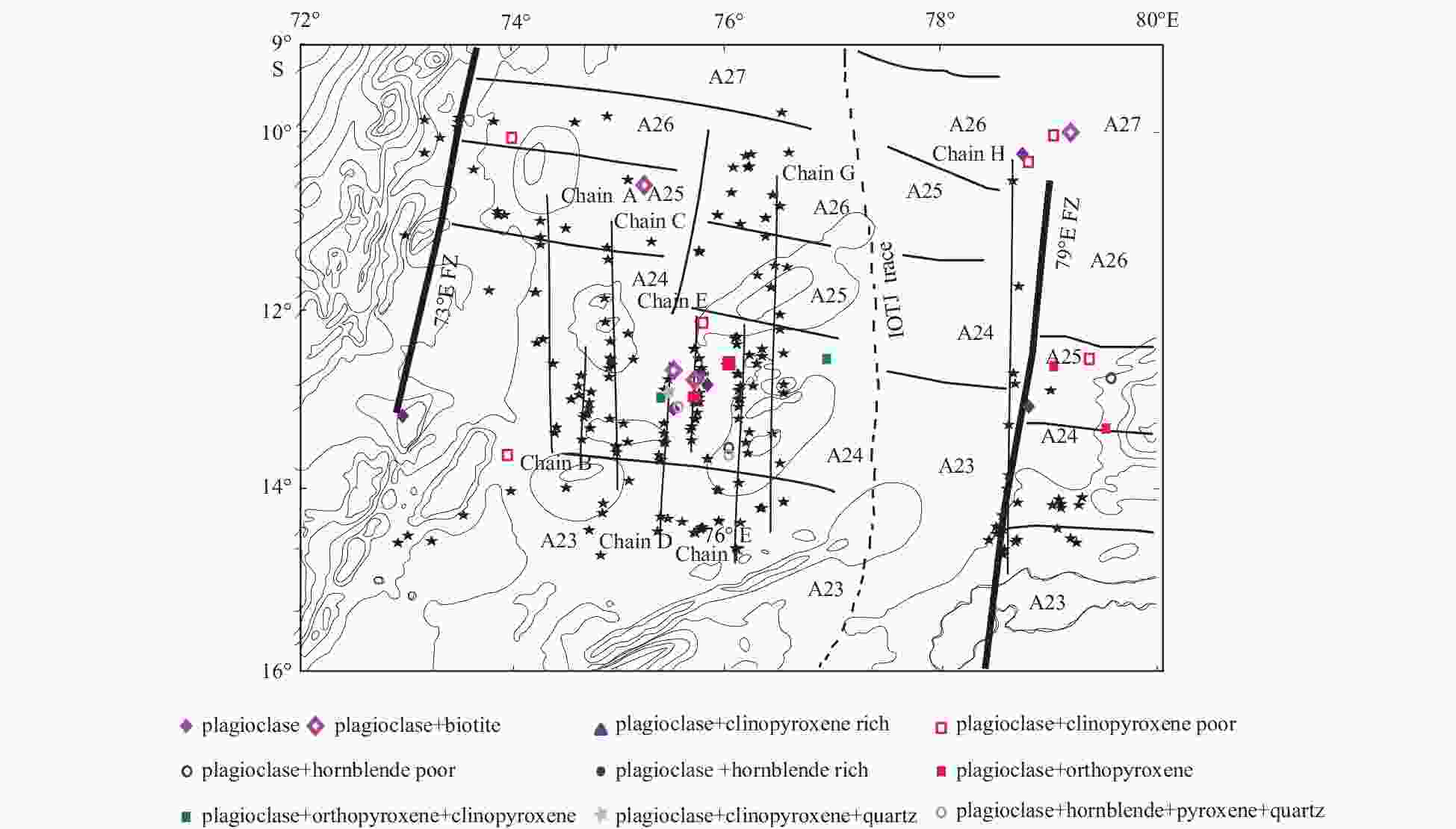
 下载:
下载:
